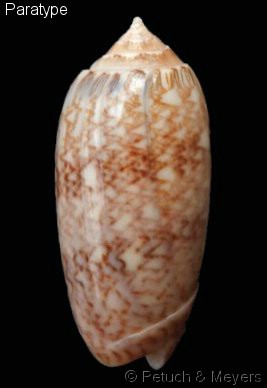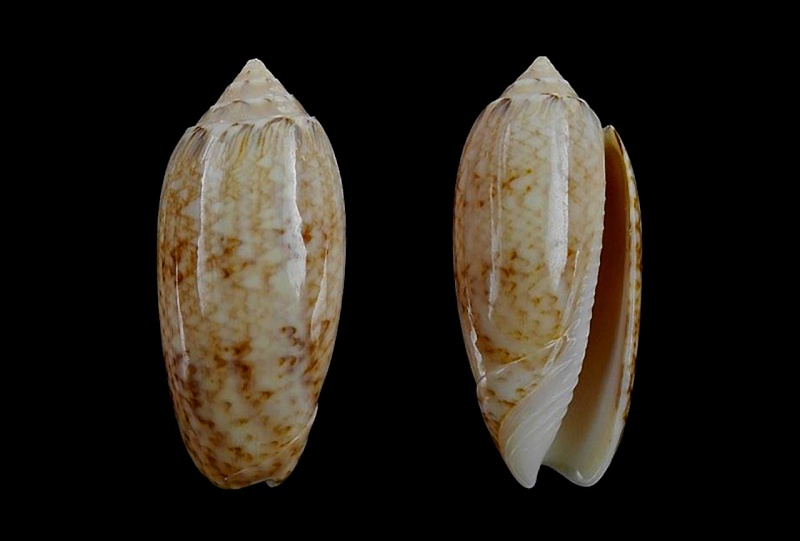 Americoliva bollingi choctaw Petuch & R.F. Myers, 2014 - Worms = OLiva nivosa bollingi (Clench, 1934)
Americoliva bollingi choctaw Petuch & R.F. Myers, 2014 - Worms = OLiva nivosa bollingi (Clench, 1934)
Sam 17 Mai 2014 - 10:41
Une autre nouveauté....


Description: Shell of average size for genus, smaller than nominate subspecies, subcylindrical and inflated, with slightly convex sides; shoulder slightly rounded, grading directly into body whorl; filament channel narrow but deep, edged by sharp, blade-like carina; fasciole and fascicular band proportionally small, narrow, confined to anterior one-fourth of body whorl; spire proportionally low, subpyramidal; spire whorls partially covered by thick callus; columella edged with 16-18 elongated teeth (holotype with 18 teeth), with posteriormost teeth being proportionally small and becoming larger and more prominent toward anterior end; posterior one-quarter of columella smooth and devoid of teeth; shell base color canary yellow, overlaid with dense, tightly-woven network of pale tan closely-packed triangles of various sizes; 2 broad bands of darker brownish-tan flammules and triangles encircle middle of body whorl, one on either side of shell mid-body; shoulder and edge of filament channel colored pale bluish-green, overlaid with closely-packed dark brown hairlines that are arranged in separate bundles; spire whorl calluses colored pale brown; fascicular band pale tan, marked with regularly-spaced small brown flammules; columellar teeth white; aperture proportionally wide , slightly arcuate, with interior colored pale cream-yellow; protoconch proportionally large, projecting, composed of 2 rounded, bulbous whorls.
Type Specimens: Holotype: length 43 mm, width 18 mm, LACM 3271; Paratypes: length 44 mm, width 19 mm, same locality as the holotype, LACM 3272; length 43 mm, width 19 mm, same locality as holotype, in the research collection of the senior author; 2 specimens, length 44 mm, width 18 mm, and length 38 mm, width 16 mm, from the same locality as the holotype, in the research collection of Pierre Recourt, The Netherlands.
Type Locality: In clean quartz sand, exposed at low tide, St. Andrew Sound, Panama City, Bay County, Florida (Apalachicola River Delta).
Range: At present, known only from the northeastern Gulf of Mexico, in the vicinity of the Apalachicola River Delta of the Florida Panhandle, where the new subspecies occurs on intertidal sand flats.
Etymology: The taxon honors the Choctaw Indian Tribe, the inhabitants of the Apalachicola River Delta and northern coast of the Gulf of Mexico at the time of the first contact with European explorers. Named as a noun in appostion.
Discussion: This new taxon is here proposed as a geographically-isolated subspecies of the wide-ranging Americoliva bollingi (Clench, 1934), which occurs along the southeastern United States coast from Georgia south to eastern Florida and the Florida Keys (Figure 1E, F) [Note: There is much confusion regarding the nomenclature of this common southeastern United States olive; A. bollingi was originally described by Clench as a subspecies of the widespread Caribbean A. reticularis (Lamarck, 1811), but it was later considered to be a subspecies of another widespread Caribbean olive, A. bifasciata (Kuster, 1878) (Petuch and Sargent, 1986: 127-128; Petuch, 2013: 35). This southeastern United States endemic olive is here considered to be a full species that is distinct from its Caribbean congeners]. Although similar in general shape and color pattern to the nominate subspecies, A. bollingi choctaw differs in being a smaller, stockier, and less elongated shell, in having proportionally wider and more-intricately patterned spiral bands around the mid-body, and in having the distinctive pale yellow base color. Typical A. bollingi bollingi has a pale blue or white base color, is larger and more elongated, and is most frequently collected in the carbonate sediments and coralline environments of southeastern Florida (from Fort Pierce to Miami) and the Florida Keys (Petuch and Sargent, 2011: 67) or from the offshore scallop beds of Georgia and northeastern Florida. No bollingi-type olives are known to occur along the intertidal areas of western Florida, from the Ten Thousand Islands north to Apalachee Bay, and the family is represented along the west coast only by the larger and more elongated Americoliva sayana (Ravenel, 1834).
Americoliva bollingi choctaw appears to represent a relictual population of the nominate subspecies that had become isolated in the northeastern Gulf of Mexico during the late Pleistocene and has undergone subsequent genetic drift. The areas of St. Andrew Sound, Apalachee Bay, and the Apalachicola Delta are all under the influence of the warm-water Gulf Loop Current, which bathes this coast with subtropical water conditions during the cold winter months. The near shore areas of western Florida south of the Suwannee River Mouth, on the other hand, are not influenced by this warm water current and are exposed to very cold winter temperatures, often near freezing. Because of these low winter water temperatures, the warm water-loving Americoliva bollingi bollingi cannot live along this coast. Conversely, the Florida Keys are continuously under the influence of the warm Florida Current and the southeastern coast of Florida is bathed by the equally-warm Gulf Stream waters. These east coast tropical marine climates support coral reefs and their adjacent carbonate sand areas, providing the ideal habitat for A. bollingi bollingi. The two subspecies also inhabit different biogeographical regions, with A. bollingi bollingi occurring within the warm water Floridian Subprovince and Palm Beach Provinciatone of the Carolinian Province, and with A. bollingi choctaw being a faunal component of the cooler water Suwannean Subprovince of the Carolinian Province (see Petuch, 2013 for descriptions of the North American provinces and subprovinces).


Americoliva bollingi choctaw new subspecies
(Figure 1G, H, I)
Description: Shell of average size for genus, smaller than nominate subspecies, subcylindrical and inflated, with slightly convex sides; shoulder slightly rounded, grading directly into body whorl; filament channel narrow but deep, edged by sharp, blade-like carina; fasciole and fascicular band proportionally small, narrow, confined to anterior one-fourth of body whorl; spire proportionally low, subpyramidal; spire whorls partially covered by thick callus; columella edged with 16-18 elongated teeth (holotype with 18 teeth), with posteriormost teeth being proportionally small and becoming larger and more prominent toward anterior end; posterior one-quarter of columella smooth and devoid of teeth; shell base color canary yellow, overlaid with dense, tightly-woven network of pale tan closely-packed triangles of various sizes; 2 broad bands of darker brownish-tan flammules and triangles encircle middle of body whorl, one on either side of shell mid-body; shoulder and edge of filament channel colored pale bluish-green, overlaid with closely-packed dark brown hairlines that are arranged in separate bundles; spire whorl calluses colored pale brown; fascicular band pale tan, marked with regularly-spaced small brown flammules; columellar teeth white; aperture proportionally wide , slightly arcuate, with interior colored pale cream-yellow; protoconch proportionally large, projecting, composed of 2 rounded, bulbous whorls.
Type Specimens: Holotype: length 43 mm, width 18 mm, LACM 3271; Paratypes: length 44 mm, width 19 mm, same locality as the holotype, LACM 3272; length 43 mm, width 19 mm, same locality as holotype, in the research collection of the senior author; 2 specimens, length 44 mm, width 18 mm, and length 38 mm, width 16 mm, from the same locality as the holotype, in the research collection of Pierre Recourt, The Netherlands.
Type Locality: In clean quartz sand, exposed at low tide, St. Andrew Sound, Panama City, Bay County, Florida (Apalachicola River Delta).
Range: At present, known only from the northeastern Gulf of Mexico, in the vicinity of the Apalachicola River Delta of the Florida Panhandle, where the new subspecies occurs on intertidal sand flats.
Etymology: The taxon honors the Choctaw Indian Tribe, the inhabitants of the Apalachicola River Delta and northern coast of the Gulf of Mexico at the time of the first contact with European explorers. Named as a noun in appostion.
Discussion: This new taxon is here proposed as a geographically-isolated subspecies of the wide-ranging Americoliva bollingi (Clench, 1934), which occurs along the southeastern United States coast from Georgia south to eastern Florida and the Florida Keys (Figure 1E, F) [Note: There is much confusion regarding the nomenclature of this common southeastern United States olive; A. bollingi was originally described by Clench as a subspecies of the widespread Caribbean A. reticularis (Lamarck, 1811), but it was later considered to be a subspecies of another widespread Caribbean olive, A. bifasciata (Kuster, 1878) (Petuch and Sargent, 1986: 127-128; Petuch, 2013: 35). This southeastern United States endemic olive is here considered to be a full species that is distinct from its Caribbean congeners]. Although similar in general shape and color pattern to the nominate subspecies, A. bollingi choctaw differs in being a smaller, stockier, and less elongated shell, in having proportionally wider and more-intricately patterned spiral bands around the mid-body, and in having the distinctive pale yellow base color. Typical A. bollingi bollingi has a pale blue or white base color, is larger and more elongated, and is most frequently collected in the carbonate sediments and coralline environments of southeastern Florida (from Fort Pierce to Miami) and the Florida Keys (Petuch and Sargent, 2011: 67) or from the offshore scallop beds of Georgia and northeastern Florida. No bollingi-type olives are known to occur along the intertidal areas of western Florida, from the Ten Thousand Islands north to Apalachee Bay, and the family is represented along the west coast only by the larger and more elongated Americoliva sayana (Ravenel, 1834).
Americoliva bollingi choctaw appears to represent a relictual population of the nominate subspecies that had become isolated in the northeastern Gulf of Mexico during the late Pleistocene and has undergone subsequent genetic drift. The areas of St. Andrew Sound, Apalachee Bay, and the Apalachicola Delta are all under the influence of the warm-water Gulf Loop Current, which bathes this coast with subtropical water conditions during the cold winter months. The near shore areas of western Florida south of the Suwannee River Mouth, on the other hand, are not influenced by this warm water current and are exposed to very cold winter temperatures, often near freezing. Because of these low winter water temperatures, the warm water-loving Americoliva bollingi bollingi cannot live along this coast. Conversely, the Florida Keys are continuously under the influence of the warm Florida Current and the southeastern coast of Florida is bathed by the equally-warm Gulf Stream waters. These east coast tropical marine climates support coral reefs and their adjacent carbonate sand areas, providing the ideal habitat for A. bollingi bollingi. The two subspecies also inhabit different biogeographical regions, with A. bollingi bollingi occurring within the warm water Floridian Subprovince and Palm Beach Provinciatone of the Carolinian Province, and with A. bollingi choctaw being a faunal component of the cooler water Suwannean Subprovince of the Carolinian Province (see Petuch, 2013 for descriptions of the North American provinces and subprovinces).
_________________
The cure for anything is salt water - sweat, tears, or the sea.
~ Isak Dinesen
 Clem4102Modérateur
Clem4102Modérateur
- Messages : 1926
Date d'inscription : 01/03/2011
Age : 47
Localisation : Corrèze
 Re: Americoliva bollingi choctaw Petuch & R.F. Myers, 2014 - Worms = OLiva nivosa bollingi (Clench, 1934)
Re: Americoliva bollingi choctaw Petuch & R.F. Myers, 2014 - Worms = OLiva nivosa bollingi (Clench, 1934)
Lun 26 Mai 2014 - 22:03
Oui, pourquoi pas, à mon sens cela ne fait que rajouter une sous espèce dans un sous genre qui en comporte un peu trop avec si peu de différence les unes par rapport aux autres.
Après si la génétique a tranché?...
Cela ne reste que mon avis bien sur.
A+
Après si la génétique a tranché?...
Cela ne reste que mon avis bien sur.
A+
 Re: Americoliva bollingi choctaw Petuch & R.F. Myers, 2014 - Worms = OLiva nivosa bollingi (Clench, 1934)
Re: Americoliva bollingi choctaw Petuch & R.F. Myers, 2014 - Worms = OLiva nivosa bollingi (Clench, 1934)
Jeu 16 Oct 2014 - 15:39
En voici 2 pour compléter l'article, elles viennent de m'arriver...
Ce sont 2 paratypes
Oliva bollingi choctaw
Americoliva
Petuch et Myers 2014
Florida.St Andrews Bay, Panama city…. Low tide on sand flats.
PARATYPES
Taille 35,1 mm

Taille 44,4 mm

Ce sont 2 paratypes
Oliva bollingi choctaw
Americoliva
Petuch et Myers 2014
Florida.St Andrews Bay, Panama city…. Low tide on sand flats.
PARATYPES
Taille 35,1 mm

Taille 44,4 mm

_________________
The cure for anything is salt water - sweat, tears, or the sea.
~ Isak Dinesen
 Bernard Clavé †Modérateur
Bernard Clavé †Modérateur
- Messages : 7271
Date d'inscription : 28/06/2011
Age : 81
Localisation : Gironde
 Re: Americoliva bollingi choctaw Petuch & R.F. Myers, 2014 - Worms = OLiva nivosa bollingi (Clench, 1934)
Re: Americoliva bollingi choctaw Petuch & R.F. Myers, 2014 - Worms = OLiva nivosa bollingi (Clench, 1934)
Jeu 5 Mar 2015 - 7:57
Tu peux nous indiquer les provenances Thierry ?
Merci d'avance.
Merci d'avance.
_________________
Je pense ce que je dis, je dis ce que je fais et je fais ce que je dis...... Et qu'importe le "Qu'en dira t'on".......



Nanard33
 Re: Americoliva bollingi choctaw Petuch & R.F. Myers, 2014 - Worms = OLiva nivosa bollingi (Clench, 1934)
Re: Americoliva bollingi choctaw Petuch & R.F. Myers, 2014 - Worms = OLiva nivosa bollingi (Clench, 1934)
Jeu 5 Mar 2015 - 8:02
Bernard CLAVÉ a écrit:Tu peux nous indiquer les provenances Thierry ?
Merci d'avance.
C est bien la peine que je mette la description avec tt les elements ...:) :)

J ai quand meme rajoute sur mon post la provenance
_________________
The cure for anything is salt water - sweat, tears, or the sea.
~ Isak Dinesen
 Bernard Clavé †Modérateur
Bernard Clavé †Modérateur
- Messages : 7271
Date d'inscription : 28/06/2011
Age : 81
Localisation : Gironde
 Re: Americoliva bollingi choctaw Petuch & R.F. Myers, 2014 - Worms = OLiva nivosa bollingi (Clench, 1934)
Re: Americoliva bollingi choctaw Petuch & R.F. Myers, 2014 - Worms = OLiva nivosa bollingi (Clench, 1934)
Jeu 5 Mar 2015 - 8:06
Thierry VULLIET a écrit:
C est bien la peine que je mette la description avec tt les elements ...:) :)
J ai quand même rajoute sur mon post la provenance
Tu connais pourtant mon allergie au "Cheyenne"........



_________________
Je pense ce que je dis, je dis ce que je fais et je fais ce que je dis...... Et qu'importe le "Qu'en dira t'on".......



Nanard33
- Contenu sponsorisé
- Americoliva bollingi maya (Petuch & Sargent, 1986) - Worms = Oliva nivosa bollingi (Clench, 1934)
- Americoliva bollingi contoyensis (Petuch & Sargent, 1986) - Worms = OLiva nivosa bollingi (Clench, 1934)
- Americoliva bollingi goajira (Petuch & Sargent, 1986) - Worms = OLiva nivosa bollingi (Clench, 1934)
- Americoliva bollingi jenseni (Petuch & Sargent, 1986) - Worms = OLiva nivosa bollingi (Clench, 1934)
- Americoliva sayana f. maya (Petuch & Sargent, 1986) - Worms = Oliva nivosa bollingi (Clench, 1934)
Permission de ce forum:
Vous ne pouvez pas répondre aux sujets dans ce forum|
|
|


